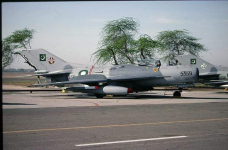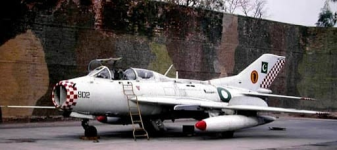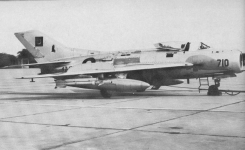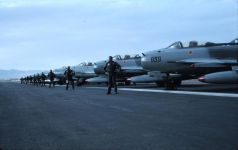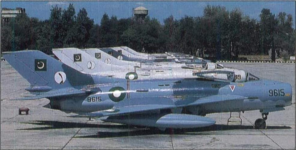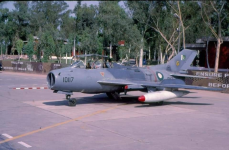Navigation
Install the app
How to install the app on iOS
Follow along with the video below to see how to install our site as a web app on your home screen.
Note: This feature may not be available in some browsers.
More options
Style variation
You are using an out of date browser. It may not display this or other websites correctly.
You should upgrade or use an alternative browser.
You should upgrade or use an alternative browser.
F-6 of Pakistan Air Force
- Thread starter ghazi52
- Start date
ghazi52
Think Tank Analyst
- Mar 21, 2007
- 116,888
- 167,109
- Country of Origin

- Country of Residence

- Thread starter
- #56
Three Pakistani F-6s from the 15th squadron, painted in the color of natural metal, in flight by formation.
Only the aircraft in the foreground is equipped with a brake parachute container at the base of the keel. Two other F-6s, "3311 black" and "1817 black", are early-type aircraft, to which the container was not installed.
All three vehicles are equipped with additional pylons under the wing for suspension of US air-to-air missiles AIM-9 "Sidwinder", such weapons were available only on Pakistani F-6.
The pylons were installed by the Pakistanis during the planned repair. Aircraft carry red stripes on the fuselage, and the blackboard side number is duplicated in the bow and tail section.
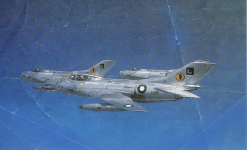
Only the aircraft in the foreground is equipped with a brake parachute container at the base of the keel. Two other F-6s, "3311 black" and "1817 black", are early-type aircraft, to which the container was not installed.
All three vehicles are equipped with additional pylons under the wing for suspension of US air-to-air missiles AIM-9 "Sidwinder", such weapons were available only on Pakistani F-6.
The pylons were installed by the Pakistanis during the planned repair. Aircraft carry red stripes on the fuselage, and the blackboard side number is duplicated in the bow and tail section.

ghazi52
Think Tank Analyst
- Mar 21, 2007
- 116,888
- 167,109
- Country of Origin

- Country of Residence

- Thread starter
- #58
Spacer run to get into gunnery pattern. F-6s ready for some action.
A spacer run to get into a gunnery pattern typically begins with the F-6 detecting and identifying the target, which in this scenario is a large sheet being dragged by another plane.
The pilot carefully plans the approach, calculating the optimal vector and trajectory to align with the target’s movement.
Initial positioning is critical, ensuring the F-6 stays out of danger while preparing for the engagement. As the F-6 closes in, precise thruster adjustments are made to match the relative velocity and direction of the target. Entering the engagement zone, the pilot locks onto the target, calibrating the weapon systems for accurate firing.
The firing sequence is initiated, with continuous adjustments to maintain target lock and ensure accuracy. After engaging the target, the F-6 performs a post-engagement maneuver to avoid potential threats and assess the damage inflicted.
This dynamic process requires skillful piloting, precise calculations, and real-time data analysis to successfully complete the gunnery pattern and achieve the mission objectives.
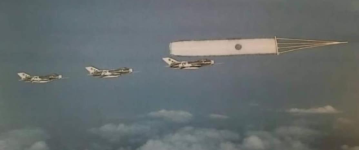
A spacer run to get into a gunnery pattern typically begins with the F-6 detecting and identifying the target, which in this scenario is a large sheet being dragged by another plane.
The pilot carefully plans the approach, calculating the optimal vector and trajectory to align with the target’s movement.
Initial positioning is critical, ensuring the F-6 stays out of danger while preparing for the engagement. As the F-6 closes in, precise thruster adjustments are made to match the relative velocity and direction of the target. Entering the engagement zone, the pilot locks onto the target, calibrating the weapon systems for accurate firing.
The firing sequence is initiated, with continuous adjustments to maintain target lock and ensure accuracy. After engaging the target, the F-6 performs a post-engagement maneuver to avoid potential threats and assess the damage inflicted.
This dynamic process requires skillful piloting, precise calculations, and real-time data analysis to successfully complete the gunnery pattern and achieve the mission objectives.

ghazi52
Think Tank Analyst
- Mar 21, 2007
- 116,888
- 167,109
- Country of Origin

- Country of Residence

- Thread starter
- #59
John Fricker, a world-renowned aviation journalist and author of the book "Battle of Pakistan Air War of 1965," visited PAF Base Mianwali in 1980 to evaluate and document the capabilities of Pakistani fighters across various bases.
During his visit to No. 14 Squadron (Tail Choppers) in Mianwali, he flew in the FT-6 with Wing Commander Mhk Dotani, the Officer Commanding No. 14 Squadron. Fricker was particularly impressed by the MiG aircraft and the exceptional flying skills of the Pakistani pilots. These photos are from the magazine Air International.

During his visit to No. 14 Squadron (Tail Choppers) in Mianwali, he flew in the FT-6 with Wing Commander Mhk Dotani, the Officer Commanding No. 14 Squadron. Fricker was particularly impressed by the MiG aircraft and the exceptional flying skills of the Pakistani pilots. These photos are from the magazine Air International.

Users who are viewing this thread
Total: 1 (members: 0, guests: 1)
Pakistan Defence Latest
-
-
-
-
Reports: Bajwa agreed to curtail Pakistan’s ballistic missile program (4 Viewers)
- Latest: Liquidator
Country Watch Latest
-
-
Why India Deliberately kept Weakened Bangladesh’s Military | InShort (12 Viewers)
- Latest: Pataliputra
-
-
Iran Cyber Security and Artificial Intelligence (civilian and military) (4 Viewers)
- Latest: Immortals
-
Not just engines, Tejas Mk-1A delivery could be hit over key Danish part, now on export blacklist (4 Viewers)
- Latest: AbuShalehRumi
Latest Posts
-
Iranian President Raisi and Foreign Minister Abdollahian die in helicopter crash in East Azerbaijan (1 Viewer)
- Latest: Persian Gulf
-
-
-
Why India Deliberately kept Weakened Bangladesh’s Military | InShort (12 Viewers)
- Latest: Pataliputra
-


